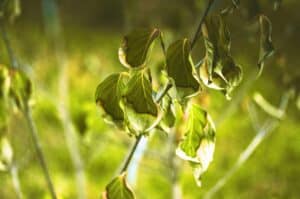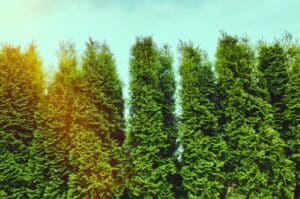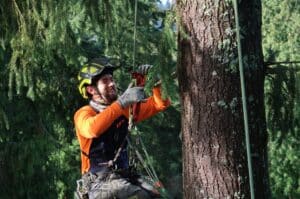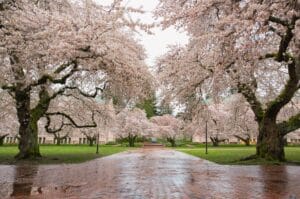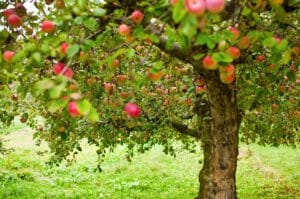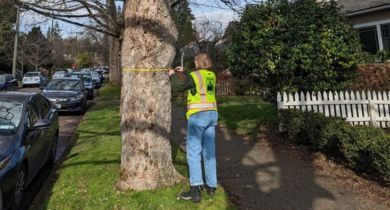Why Winter is the Best Time to Prune Trees in Seattle
Wondering when the best time to prune trees is? Find out how winter pruning in Seattle keeps your trees healthy, protects your property, and saves money.
When is the best time to prune trees here in Seattle? While pruning can be done year-round with great success, there’s an ideal pruning season that maximizes tree health while minimizing tree stress.
Most pruning projects are best done during the winter when trees are dormant. While you certainly don’t have to wait until winter, here are a few good reasons to consider it.
Key Takeaways
- Winter pruning helps trees heal faster and stay healthier because they’re dormant and less stressed.
- Leafless trees make it easier to spot problems and make precise cuts in the right places.
- Winter pruning can help prevent storm damage and costly emergency repairs.
- Regular winter maintenance saves money, protects property value, and improves energy efficiency.
Does Pruning Affect Tree Health?
When we prune trees, we’re removing branches – and yes, this does cause some stress. But good timing and proper technique make a big difference in how well trees recover.
Here in Seattle, summer pruning can be especially hard on trees. During hot, dry months, trees already struggle with heat and drought stress, making them more vulnerable to pests and diseases. They have less energy for healing, which means pruning cuts take longer to recover.
Winter pruning makes perfect sense because trees are dormant during this season, resting and storing energy for spring. With no leaves to support and no new growth to produce, they can focus on healing pruning cuts more effectively, without the stress of summer heat.
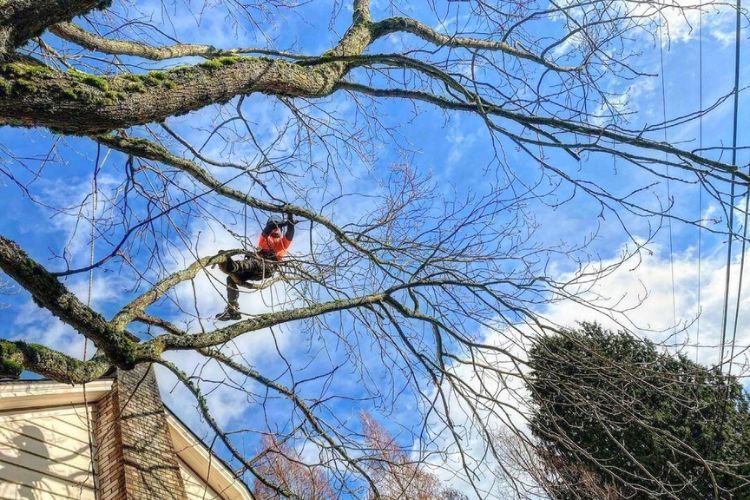
Why Winter is the Best Time to Prune
Here in Seattle, winter creates perfect conditions for pruning most deciduous trees and shrubs. This dormant state gives us the best opportunity to prune in a way that helps both your trees and your property. Here’s how:
Fewer Pests and Diseases
Winter’s cold temperatures greatly reduce the risk of pests and diseases affecting pruning cuts. Most insects are inactive at this time, and decay fungi spread much more slowly in cold weather.
This gives fresh pruning cuts time to develop strong protective barriers. Your trees can heal more effectively, sealing off the wounded area, and building up sturdy wound wood that will protect them from future problems.
Clear View of Branch Structure
When trees lose their leaves in winter, we can see exactly how they’re built. This makes it much easier to spot potential problems like cracked, broken, or poorly attached branches that might cause trouble later.
Our arborists can better examine how branches connect to the trunk, their spacing, and the overall shape of the tree’s crown. This clear view helps us make more precise and effective pruning cuts.
Better Light Management
Winter pruning lets us plan ahead for your garden’s sunlight needs. Through careful thinning, we can make sure your garden beds and lawn will get the right amount of sun once spring arrives. This thoughtful approach helps create the perfect balance between shade and sunlight for all the plants in your yard.
Stronger Spring Growth
When we prune during winter dormancy, trees can use their stored energy more efficiently when spring arrives. Think of it like having a fresh start – by removing damaged or dying limbs during winter rest, trees won’t waste energy on weak branches when it’s time to sprout new, healthy growth.
Less Unwanted Growth
Trees pruned in winter are less likely to grow water sprouts and suckers, which are small, weak branches that often pop up after summer pruning.
Since trees are dormant, they won’t react to pruning by sprouting these unwanted branches. This means your tree keeps its natural shape longer and needs less maintenance.
Better for Fruit Trees
Winter is especially good for pruning fruit trees. When we prune during their dormant period, fruit trees can direct spring growth to their strongest branches, rather than spreading that energy out among a bunch of weak branches.
This leads to higher quality fruit production and makes harvesting easier since we can shape the tree for better access.
Yes, You Can Prune Trees Year-Round, But…
While winter is the best time to prune most trees, we can safely prune in Seattle any time of year. Winter is just more forgiving, allowing us to do bigger pruning jobs. During growing seasons, you’ll want Certified Arborists handling your pruning because we know exactly how much to remove without causing too much stress to your trees.
And remember, don’t wait to remove hazardous branches – safety issues need immediate attention no matter the season.
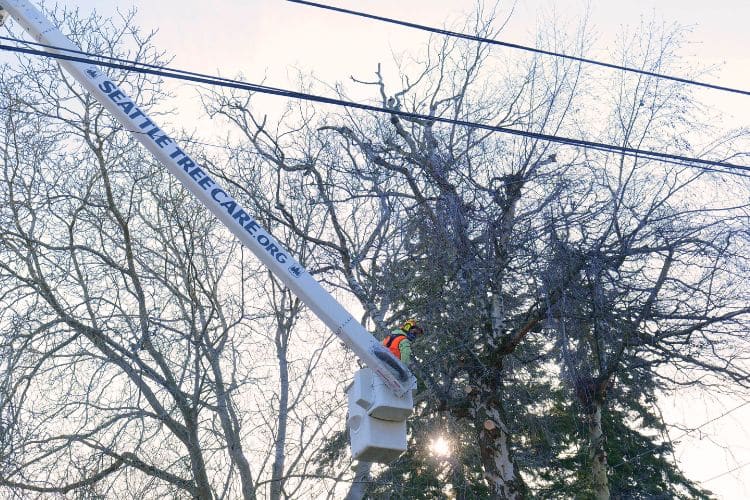
Signs Your Trees Need Pruning
Here are clear warning signs that your trees need attention:
- Safety Issues: When trees grow too large or branches touch your house or power lines, they need immediate attention. These branches can damage your roof, create dangerous situations, and encourage pest activity in your home.
- Winter Cracks: Seattle’s changing temperatures can cause branches to crack during winter. These cracks weaken branches and make them more likely to break in storms.
- Signs of Disease: Spots of mold or fungus on your tree tell you something’s wrong. Just like any infection, tree diseases can spread. Pruning helps to prevent problems from spreading to healthy parts of the tree.
- Damaged Branches: Branches that are torn, damaged, or pulling away from the tree need to be removed. These branches can fall without warning and damage your property.
- Branches Rubbing Together: When branches rub against each other, they damage the tree’s protective bark. These damaged spots make it easy for diseases to get in.
- Heavy Shade: If your tree’s canopy blocks too much light, it needs thinning. An overly dense canopy can harm your yard and trap moisture against your home.
- Weak Branch Attachments: Some branches don’t connect to the tree as strongly as they should, such as those with V-shaped branch unions. Even if they look fine now, these weak spots often break during Seattle’s winter storms.
If you spot any of these signs, it’s smart to call a professional arborist. These problems may be easier to spot and safer to fix during winter, before they turn into expensive emergency repairs.
Benefits of Winter Pruning in Seattle
Professional tree pruning does more than make your trees look better – it protects your property and helps your whole yard stay healthy and look beautiful. While we need to prune carefully to avoid harming trees, proper winter pruning is beneficial in countless ways:
- Healthier Trees and Better Growth: Winter pruning helps trees stay strong by removing damaged or diseased branches before problems spread. Fruit trees pruned in winter produce better crops next season.
- Storm Damage Prevention: Dead or damaged branches can fall anytime, damaging roofs, cars, and other property. Winter pruning removes these hazards before Seattle’s storms hit.
- Lower Maintenance Costs: Emergency tree work after a storm costs much more than regular maintenance. Winter pruning helps you avoid these expensive surprises.
- Better Light and Views: Well-pruned trees let the right amount of light into your yard, helping lawns and gardens thrive. For Seattle homes with views of the Sound or mountains, smart pruning maintains these views while keeping trees healthy.
- Energy Bill Savings: Proper pruning creates perfect shade in summer to reduce cooling costs. In winter, strategic trimming lets in more sunlight to help heat your home naturally.
- Roof Protection: Removing branches that hang over your roof helps prevent moisture damage and reduces moss growth, extending your roof’s life.
- Better Spring Growth: When we remove problem branches in winter, trees can direct their energy to healthy growth when spring arrives.
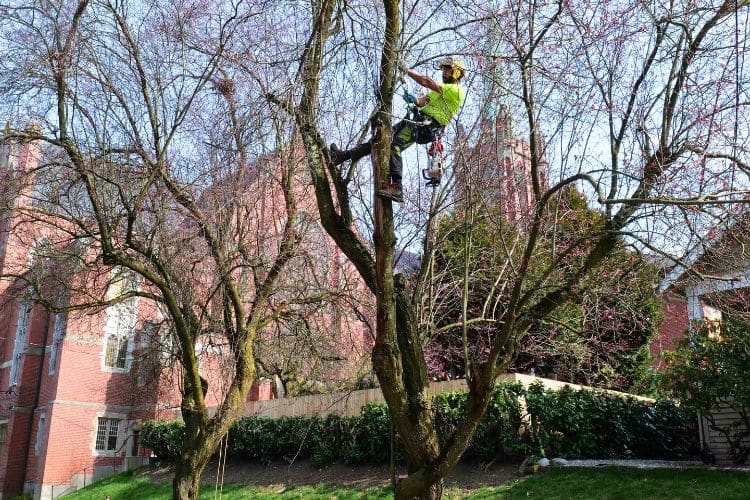
Don’t Over-Prune Your Trees
While winter is a great time for tree pruning, success depends on pruning the right amount. Many people don’t realize that over-pruning can harm trees just as much as neglecting them. Here’s what you need to know about balanced pruning:
- Start with Clear Goals: Your arborist will focus on making the smallest number of cuts needed to address your specific concerns, whether that’s safety, views, or tree health.
- Protect Wildlife: Some dead wood can safely remain to provide important habitat for birds and other wildlife that need these areas for nesting and food.
- Use Minimal Cuts: Good pruning removes just enough to solve the problem – keeping your tree’s natural shape while addressing your needs.
- Consider Timing: While winter pruning is ideal, especially since it doesn’t disturb nesting birds, trees can handle proper pruning any time of year if it’s done correctly.
Remember: the goal isn’t to remove as much as possible, but rather to make precise, purposeful cuts that benefit both your property and the tree’s long-term health. Talk to a Certified Arborist about creating a pruning plan that works for your specific situation.
FAQs About Winter Pruning
What happens if we get a sudden freeze after pruning?
Seattle’s mild winters rarely cause issues with pruning cuts. Our maritime climate keeps temperatures moderate, and properly made cuts will heal well even during sudden cold snaps.
Can you prune my trees if there’s snow on the ground?
While snow is rare in Seattle, our arborists can safely work in light snow conditions. However, we’ll reschedule if conditions are unsafe for our crew or could result in poor visibility of the tree’s structure.
If my neighbor’s tree branches hang over my property, can I prune them in winter?
While you legally can trim branches that cross your property line, it’s best to discuss this with your neighbor first and hire a professional arborist together. Improper pruning could damage the tree and create liability issues for both property owners.
What should I do to prepare my yard for winter pruning?
Before your scheduled pruning, clear any items from under your trees and make sure arborists can easily access the trees. If possible, mark any sensitive plants or garden areas you want to protect during the work.
Plan Your Winter Pruning Now with Seattle Tree Care
Winter pruning is one of the smartest investments you can make for your Seattle property. It protects your trees and home while preventing costly emergency repairs. Don’t wait until storm damage or spring growth creates expensive problems.
Seattle Tree Care’s Certified Arborists are ready to help you make the most of this winter pruning season. Call us today at 206-789-0534 or use our online form to request a free quote and get on our winter pruning schedule now.
Recent Articles
Looking for More?
We've got you covered with tips, resources, updates, how-to's, and other helpful information about trees and landscapes in Seattle, Puget Sound, and King County, WA. Join the thousands of smart local residents who get the monthly newsletter from Seattle Tree Care for helpful information you won't want to miss!
There's no spam - we promise! We are committed to keeping your e-mail address confidential. We do not sell, rent, or lease our contact data or lists to third parties.


